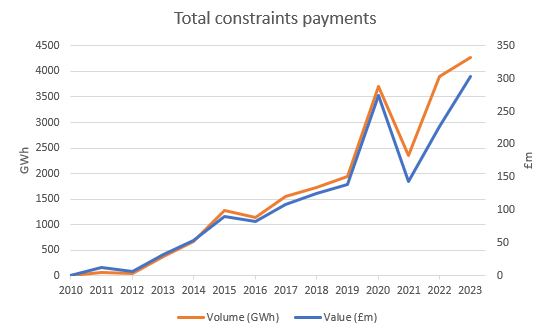Two windfarms share £80 million to switch off
The cost to consumers of so-called windfarm constraint payments is rising quickly.
Regular readers will know that I have long been concerned over the extraordinary level of payments to windfarms to switch off. These so-called ‘constraint payments’ are deemed necessary when the wires in the transmission grid have inadequate capacity to get a generator’s power to market. When that happens, the windfarm (and it is always a windfarm) is paid to switch off, and a gas-fired power station is paid to switch on so that the end user of the electricity is not left short.
This is particularly a problem for windfarms in Scottish waters, because there is relatively little transmission capacity running across the border to England, where most of the power users are found. In 2022, I noted that the offshore windfarm called Moray East had spent 25% of the previous year switched off. The suspicion is that there may be perverse incentives for developers to build windfarms in Scotland precisely so they receive constraint payments.
With a large new offshore windfarm called Seagreen coming on stream in 2023, I was interested to see how things had developed. The data, taken from the Renewable Energy Foundation, is revealing.
Figure 1 shows that the total payments to windfarms has risen to £303 million, off a constrained volume of 4.3 terawatt hours. That’s roughly four days’ electricity demand thrown away entirely.
Figure 1: Windfarm constraint payments
And if we break down the 2023 bill, we can see that once again it is the canny Scots who are the big beneficiaries (Figure 2), with Moray East getting an extraordinary £43 million, and Seagreen (as expected) not far behind at £39 million.
Figure 2: Windfarm constraint payments 2023
Moray East’s constrained volume is 590 GWh, which will represent something like 20% of its output. Seagreen’s is 759 GWh, which will be somewhat higher.
Interestingly, payments to Moray East’s neighbour, Beatrice, have fallen away sharply, from £33 million in 2022 to just £9 million in 2023. I don’t know why this is.
In summary then, the rip-off continues, and indeed is getting worse.


